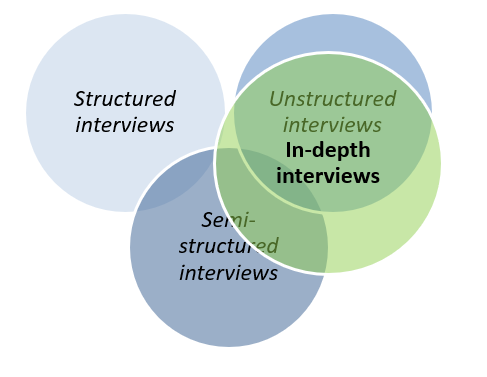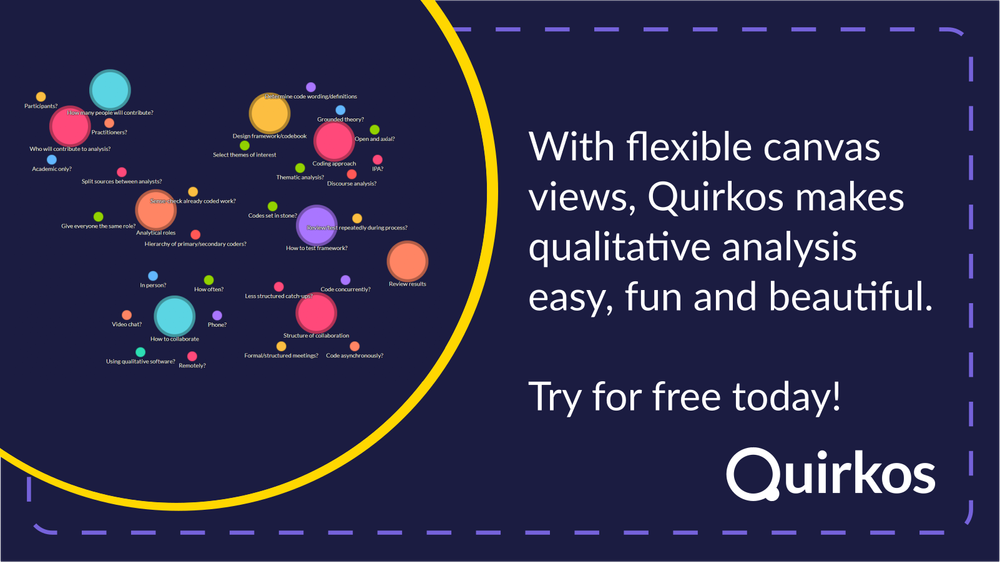In-depth interviews in qualitative research: Not 'just a chat'
'In-depth interview, that's just a chat', you might say. Well, no, it's not, and here's why, and when to use it.

What is an in-depth interview?
In-depth interviews are described by Fontana and Frey (2000) as a kind of interview that uses anything from structured questions to 'negotiated text', but they also describe it as open-ended and ethnographic. More helpfully, they say it is used as an attempt “to understand the complex behaviour of members of society without imposing any a-priori categorization that may limit the field of inquiry”. They also consider the establishment of a ‘human-to-human connection’, as fundamental to in-depth interviews.
Well, you might say, that’s still just chat, but a really long one, isn’t it? Well no.
According to Kvale and Brinkmann (2009), in-depth interviews are considered to be research conversations. As a genre of conversation, an in-depth interview has its own conventions and rules, distinct from a chat with a friend, a legal interrogation, a therapeutic session, or professional discussion. What makes them distinct is the purpose of the conversation. In qualitative research the purpose is to 'produce' knowledge, “is an interview where knowledge is constructed in the inter-action between the interviewer and the interviewee”. However there is much overlap and no hard and fast distinction between different forms of conversation.
So, ‘chatting’ around inconsequential topics (the state of traffic, whether you prefer tea or coffee) might genuinely be part of the forming and maintenance of rapport. However trust and genuine interview dialogue will be developed through human skills and behaviours that demonstrate that you are trustworthy, respectful of the knowledge and person(s) you are working with, genuinely want to hear what they have to say, see what they have to show you, and will be careful in your representation. These are skills that we all have at some level, but with practice can be honed to the point where you know when to ask a sensitive question, probe more deeply or return at a later point; can detect that there is more to be heard or you can move on; can select from a variety of questioning techniques; have sharp observation skills, and fundamentally, know how to actively listen.
It is probably apparent by now that in-depth interviews are time consuming and take some skill. However, as Guest, Namey & Mitchell say, “there is good reason for the pervasiveness of this method: it is versatile across a range of study topics, adaptable to challenging field conditions, and excellent for not just providing information but for generating understanding as well.” (2013)
When should you use an in-depth interview?
Fontana and Frey (2020) call in-depth interviews ethnographic and open-ended. So in-depth interviews are suitable for the kind of topics where the researcher needs to be in the ‘field’ under examination and/or close to people the people who inhabit that field. Subjects that could require that kind of closeness include:
- Socially sensitive topics such as bereavement, abuse of any kind, financial issues
- Marginalised and closed groups
- Life-course or bibliographic accounts
- Examining professional practice in detail
You may also choose to do in-depth interviews when access to the field is limited, or where there are elements of danger, such as gangs, criminal processes, dangerous or controlled workplaces with restricted access (diving, oil-rigs, operating theatres).
You might also choose to combine in-depth interviews with more traditional ethnographic techniques, such as observation, or with more creative and arts-based methods, where the co-construction of knowledge can be physically made manifest in ways beyond an academic report.
What’s the role of the researcher in an in-depth interview?
Acknowledging that subjective experience is valuable and that the researcher needs to be aware of their own subjectivities are givens in any qualitative research. The literature describes the involvement of the interviewer in research conversations in many ways, from ‘listen, don’t talk, (which might sit well with a more therapeutic approach), all the way to sharing personal opinions, likes/dislikes, which contribute to the co-construction of knowledge. Kvale and Brinkmann (2009) even discuss more challenging styles, where the interviewer freely expresses disagreement with interviewees. There is an element of personality and competence involved in this choice, but your particular research question should guide you across the spectrum of roles, from quiet researcher, to knowledgeable peer, or activist with a purpose of social change.
However there are four areas of consensus in researcher approach:
Four key tips for conducting an in-depth interview
- Listen more than you talk
- Take time to develop genuine rapport
- Understand your purpose
- Don’t give advice
This is all probably good guidance for any kind of interview, but fail in the first of these two and you cannot claim to be using in-depth interviews in any methodological sense. As for not giving advice, you would need to have a good ethical and methodological rationale for why you might be asked for advice, and how you would handle that appropriately.
Do you need an interview guide for an in-depth interview?
Usually: as the Wallace foundation workbook suggests, you will need a guide with some sense of the questions you could ask, and the areas that you wish to cover (as well as a sampling strategy and thoughts on how you will make sense of your findings). However, that doesn’t mean you have to clutch it in your hand and read from it throughout your interviews.
Our blog on semi-structured interview guides recommends that you learn all of the questions in your topic guide/interview guide, and keep the guide near to hand. Certainly being able to glide seamlessly from question to question, topic to topic really helps keep interviews on track, when each participant may only cover different parts of the topic. However, it is knowing the purpose of your guide that is important, not the order of the questions or verbatim regurgitation of the questions. If you find forming questions difficult, why not have some generalised starters on your guide, along with purpose, and go from there? Our blog Talking naturally in qualitative research interviews has a whole section on questions to help you keep going with your in-depth interview.
What's the difference between in-depth, unstructured and structured interviews?
There are so many ways to describe interviews that it can appear a bit random, with authors like Flick (2015), using labels that refer not just to the structure of the interview (e.g. semi-structured), but also to the people to be interviewed, their status relative to the context under discussion (e.g. expert, adult or child service user), and the linguistic form of the interview (e.g. narrative, and episodic). Then to add to the confusion, we throw in another term like ‘in-depth’.
The three forms of interview
In general, research interviews can be divided into three kinds of structure:
- Structured interviews
- Semi-structured interviews
- Unstructured interviews
In-depth interviews generally overlap the area between Unstructured and Semi-structured interviews. In Figure 1, the In-depth interviews circle barely skims the Structured interview circle. It is possible to use a structured interview instrument that is extremely detailed, wide-ranging and long. However, these are rare, as gathering such data is often better served by a questionnaire, and they are not in-depth in a qualitative methodological sense. When you find yourself choosing in-depth interviews, you are looking to generate a rich dialogue between you and your interviewee that will allow both of you to explore a topic in a free-flowing and informative way.

How can software help with your in-depth interviews?
Whatever type of interviews you end up using for your qualitative research, Quirkos is a great way to transcribe them, with our automated transcription service, and analyse them with our simple qualitative coding and analysis tool. You can try both free of charge for 14 days, so register for a free trial and see if Quirkos can help you after your interviews!

References and Resources
Fontana, Andrea. and Frey, James H. (2000) The interview; from structured questions to negotiated text. In Handbook of Qualitative Research, Eds. Norman K. Denzin, Yvonna S. Lincoln. Sage.
Flick, Uwe. (2015) Introducing Research Methodology: A Beginner's Guide to Doing a Research Project 2nd Ed. Sage.
Guest, G., Namey, E., & Mitchell, M. (2013). in-depth interviews. (Vols. 1-0). SAGE Publications, Ltd, https://doi.org/10.4135/9781506374680[Accessed online 03 July 2023]
Kvale, Steinar (1996) InterViews: An introduction to research interviewing. Sage. Thousand Oaks. London.
Kvale, Steinar and Brinkmann, Svend (2009) (2014) InterViews: Learning the Craft of Qualitative Research Interviewing. Sage. Thousand Oaks. London.
Morris, A. (2015). A practical introduction to in-depth interviewing. SAGE Publications Ltd, https://doi.org/10.4135/9781473921344
The Wallace Foundation’s Knowledge Center, has useful material about many issues, including the arts, learning enrichment and school leadership. https://www.wallacefoundation.org/knowledge-center/pages/kc-results.aspx
